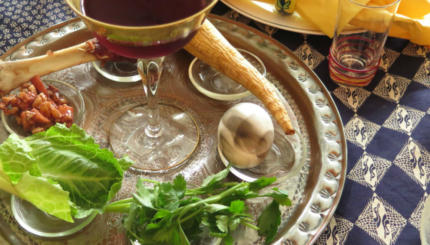Passover, the annual celebration of the Exodus from Egypt, is one of Judaism’s most beloved holidays — and also the one that requires the most preparation. The Torah teaches that one should remove leaven or hametz (understood by Jewish tradition to mean food that is made from one of five forbidden grains and food that has been fermented) from one’s home — it should neither be seen nor found in one’s possession.
Traditionally, Jews attempt to clean all the leaven from their homes, chasing out the cracker crumbs and stray Cheerios wherever they lurk: behind the refrigerator, in the pockets of coats, under car seats. Larger leavened items, like boxes of pasta and crackers, are often sold to non-Jewish neighbors with the understanding that these will be purchased back at the end of the holiday.
Aside from the comprehensive nature of this kind of purge, because Passover cleaning often coincides with spring cleaning, many find the undertaking overwhelming and daunting. But obsession is not necessarily required to satisfy the traditional requirements of the holiday. If it all seems too much, it may be that you are doing more than you need to. Here are our tips for keeping your Passover cleaning manageable:
Hametz is not Dirt
Yes, crumbs of food often lurk in the same places one finds dirt and grime, but there is no requirement that the home be clean, only that it be purged of leaven. You really don’t need to dust your fan blades.

Help us keep Jewish knowledge accessible to millions of people around the world.
Your donation to My Jewish Learning fuels endless journeys of Jewish discovery. With your help, My Jewish Learning can continue to provide nonstop opportunities for learning, connection and growth.
Focus on the Kitchen
You are not likely to eat in your bathroom, so skip that space when doing your Passover cleaning. Keep your focus on the places where you prepare and eat your food — dayenu!
Some Hametz Doesn’t Count
Some authorities say that hametz is only a problem if it is the size of an olive or larger. So those tiny crumbs you’re desperately seeking out? Not so significant.
Some authorities say that hametz which is not edible also doesn’t count. What’s “inedible”? If a dog wouldn’t eat it you probably wouldn’t either.
Throw Your Hametz in a Cardboard Box or Just Tape Up the Cabinet
Once you sell your leaven products they no longer belong to you. The only other requirement is that you should not see them. So grab a cardboard box, a sheet or some masking tape and hide those cookies that now technically belongs to someone else from view. Done and done.
Nullification is Your Friend
On the night before the first seder, it is traditional to hide a few last crumbs of bread and then search for them by candlelight. The following morning, these are burned (biur) and then a blessing is recited that renders any unseen leaven no longer hametz (bittul):
All hametz that is in my possession, which I have neither seen nor removed, and of which I am unaware, is nullified and ownerless like the dust of the earth.
Our sages understood that it is pretty much impossible to get everything. In fact, the Talmud implies that sometimes a person would accidentally forget about a cake in their cupboard on Passover! So do your best, say this blessing and relax. Whatever you missed (and you surely missed something — everyone does!) has symbolically turned to dust.
Passover is the festival of freedom. If you can’t enjoy the cleaning, at least don’t let it enslave you. Chag Kasher v’Sameach!



